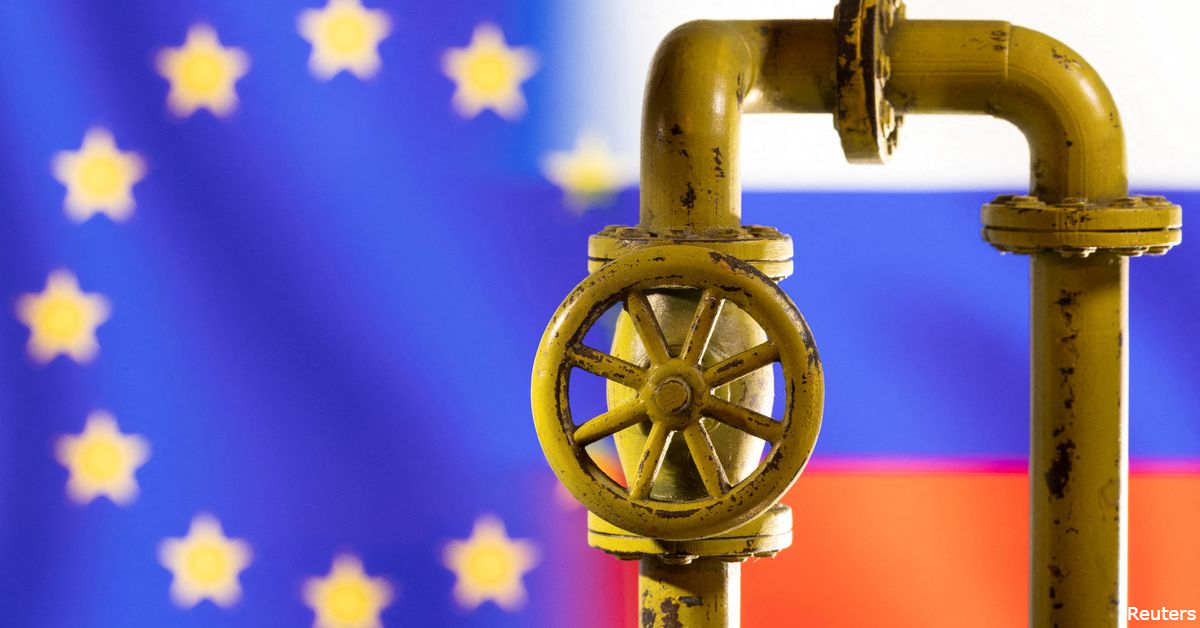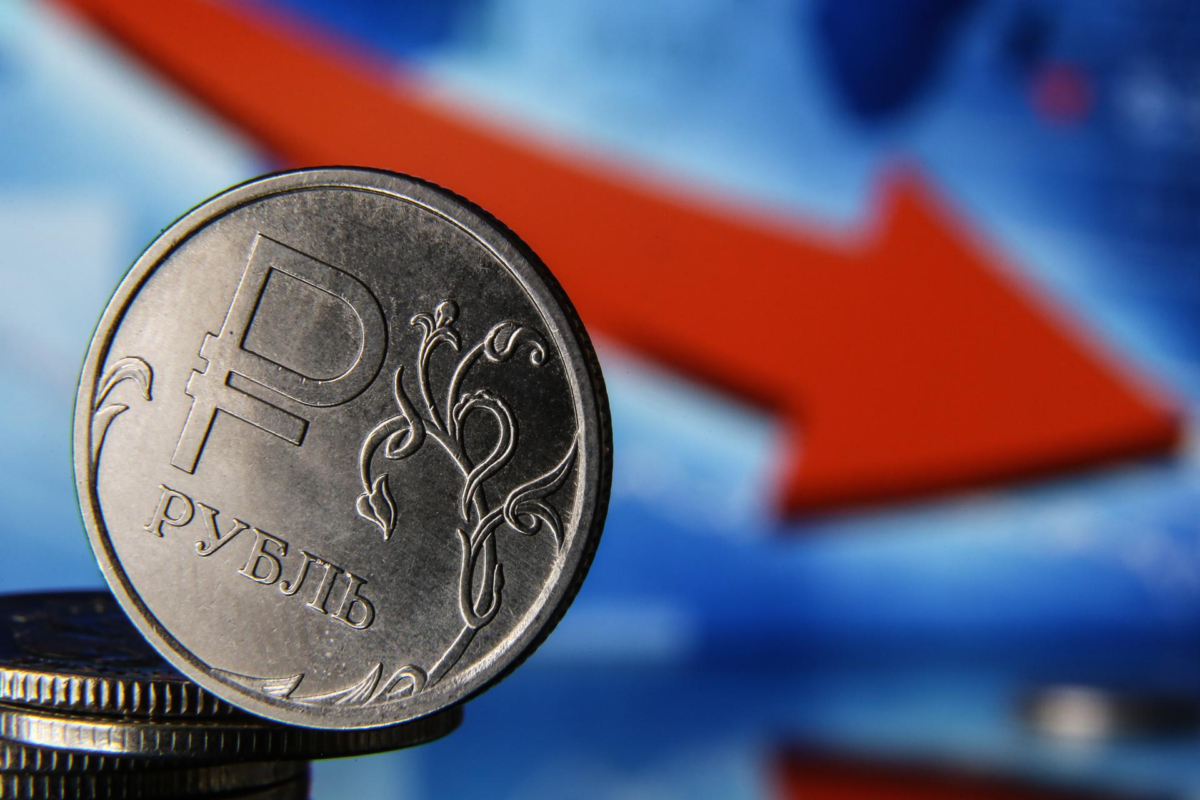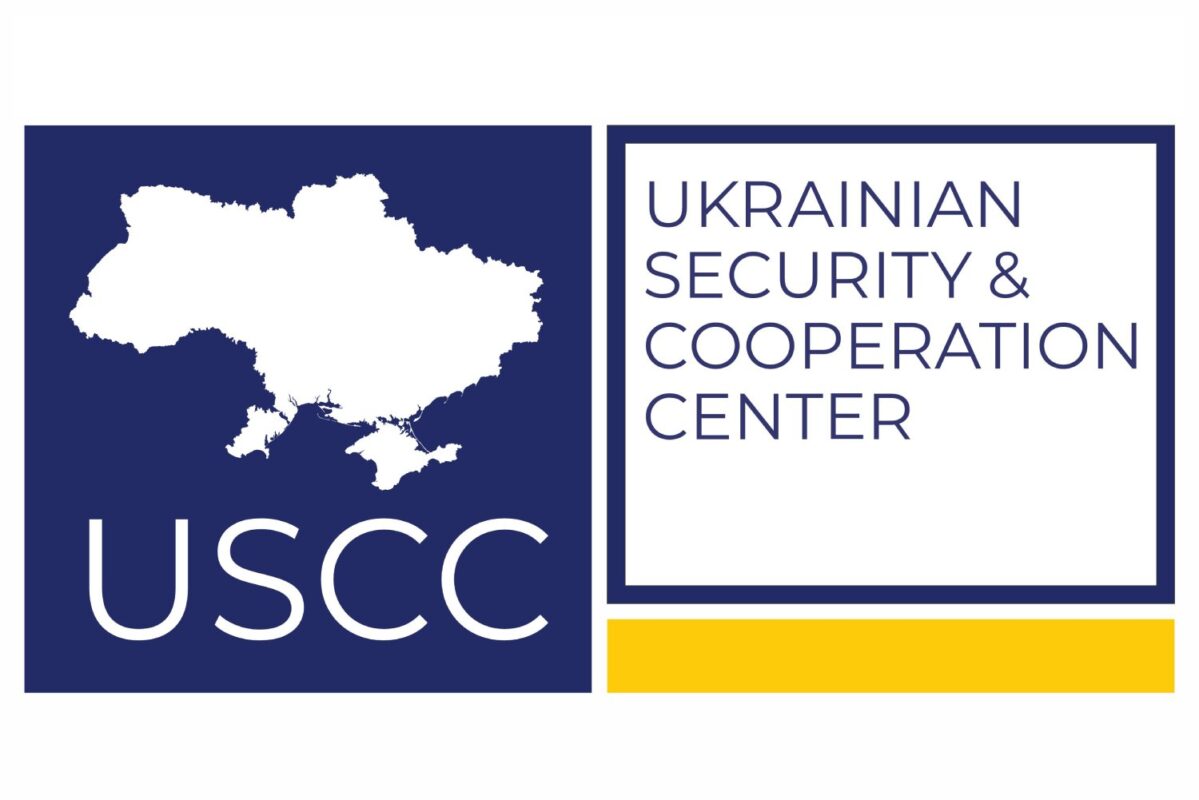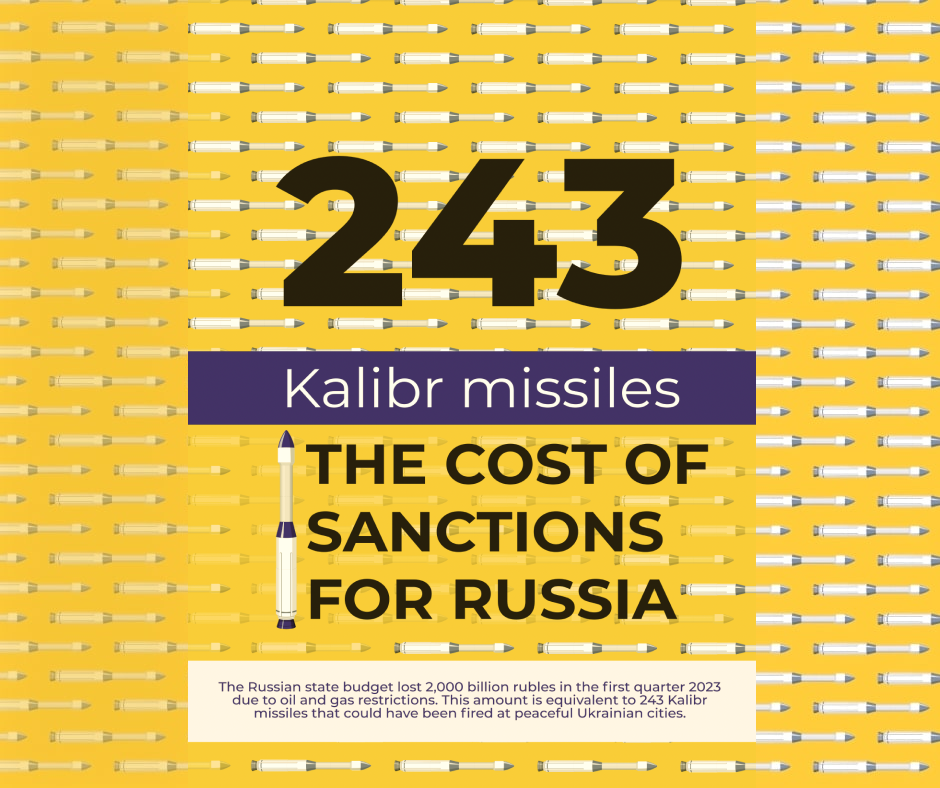For a long time, Russian propaganda has been spreading the thesis that sanctions do not affect its economy. This opinion is especially loud for Western countries. In this material, we analyse how the sanctions have affected the state of the Russian Federation for more than a year of full-scale war.
In 2022, the Russian Federation was recognized as the most sanctioned country, far ahead of Iran and the DPRK. The sanctions were aimed to weaken the Russian economy so that it would not have the resources and capabilities to wage war against Ukraine.
It is worth noting that such consequences are a maximum plan for such a long-term process as the imposition and impact of sanctions. More than a year has passed since the start of the major offensive on February 24, but no global collapse happened. The Russian economy is still “afloat,” and the war in Ukraine continues. All these facts have become the basis for Russian propaganda about the ineffectiveness of sanctions, but their real effect has actually broken the wings of the Russian two-headed chicken.
What are the consequences of the sanctions policy for Russia – let’s find out in the analytical material from the experts of the Ukrainian Security and Cooperation Center.
MANIPULATION “ON THE NUMBERS”
The most influential sanctions against Russia were imposed by the United States, Canada, the United Kingdom, and the European Union. In total, more than 40 countries from around the world have joined the sanctions. The restrictions relate to the energy and banking sectors, the military-industrial complex, the machine-building sector, etc. Western countries also imposed sanctions on more than 1,000 Russian individuals and companies, including oligarchs close to the Kremlin.
Despite this, the Russian economy did not face a fatal collapse in 2022: in 2022, Russia’s GDP fell by at least 2.2% under the best-case scenario and up to 3.9% under the worst-case scenario. Although many international experts and financial research organizations had predicted a 10-15% drop in the economy, Russia managed to avoid this.
Russian propagandists and supporters of Russia in the West use these data to justify their resistance to sanctions. In the article “Don’t believe the Russian numbers,” Agathe Demare, an American economist and head of the Economic Global Forecasting Group at The Economist, argues: ” That number has entered the policy debate: For some, the low figure is proof that the Russian economy is resilient and sanctions do not work. Others use the same figure to argue that sanctions are starting to bite and Western countries should double down. These opposing arguments have one thing in common: They rely on a largely meaningless number”.
In fact, this number does not provide us with real information. Economic experts argue that the slight drop in GDP is due to the Central Bank’s emergency measures with financial restrictions within the country, the use of the reserve National Welfare Fund, the growth of the military-industrial complex, which is fully focused on the war against Ukraine, and oil and gas revenues due to the jump in energy prices in early 2022.
European sanctions are gradual. There are many reasons for this. Sometimes important sanctions, that have strong impact on certain sectors of the Russian economy, can take a long time to be adopted, or the same sanctions come into effect some period after they were adopted. For example, oil sanctions with a six-month delay came into effect on December 5, 2022, and fuel sanctions only at the beginning of this year, on February 5, 2023. This time was given to the EU countries for finding new ways to supply energy resources , and reduce pressure on the economy.
International experts claim that Russia’s economic problems will worsen significantly and become critical to some extent in 2023-2024, as the most painful sanctions will start its significant impact only a year or two after they were imposed.
GOLDEN OIL WILL STAY IN RUSSIA
One of the main reasons for the fall of the Russian economy will be sanctions related to oil and gas products, which form the largest part of Russia’s revenues. In the pre-war years, 60-70% of Moscow’s export revenues came from trade of oil and gas. About 40% of the total federal budget was formed with funds from oil and gas export revenues, and half of the exports of oil products were to the European Union.
The EU restrictions on Russian oil and gas were only adopted at the end of 2022. The embargo on the transportation and import of Russian oil and oil products by sea and the oil price ceiling will significantly affect the deterioration of oil revenues that Russia is used to receiving steadily from the EU.
In its March report, the Kyiv School of Economics forecasts on the Russian economy for 2023, pointing out that the EU embargo on Russian oil and oil products is affecting energy export revenues, and price restrictions by the G7 countries have lowered market prices. Further sanctions, such as lowering the price ceiling for crude oil and petroleum products, as well as a ban on the transportation of Russian liquefied and pipeline gas other than through the territory of Ukraine, may increase pressure and lead to a further downsize in oil production.
As a result, these sanctions restrictions and measures are expected to reduce Russia’s revenues by an additional $56 billion in 2023 and $66 billion in 2024.
Regarding the Russian gas exports, things are also quite difficult for Moscow. Since the beginning of 2022, EU countries have been massively reducing their imports of Russian gas, having realised the risks of dependence on Russian energy resources. For example, in 2020, the part of Russian gas in Europe was 50% of the total volume imported from abroad, and at the end of 2022, this part fell to 11%, which shows a huge difference.

At the same time, price ceiling for Russian gas is being introduced, to which is added the issue of the impossibility of redistributing gas exports to other regions, as in the case with oil, due to the lack of necessary infrastructure. As a result, Russia is practically losing its gas market.
The oil and gas sanctions really work and reduce the Kremlin’s ability to finance the war in Ukraine, which now constitute the largest percentage of Russia’s budget spendings. According to Reuters, the International Energy Agency said that due to Western sanctions and price ceiling, Russia’s oil and gas export revenues in January 2023 fell by almost 40% compared to the same period last year. According to the report of KSE Institute, in 2023, only due to the sanctions already in place, Russia’s revenues from oil and gas sales will drop by half to $166 billion. The Russian Ministry of Finance is already reporting a significant federal budget deficit in the first quarter, with the deficit amounting to 2 trillion 400 billion rubles, which shows the effectiveness of the sanctions.
Earlier, the Russian authorities and media systematically tried to reinforce the thesis that sanctions have no effect on the Russian economy, but in late March, even Vladimir Putin stated: “The illegitimate restrictions imposed on the Russian economy may indeed have a negative impact on it in the medium-term perspective. In this regard, we need to ensure a steady increase in domestic demand.”

In addition to economic sanctions, those aimed at high technology are also extremely important and include restrictions on the export of critical technologies and industrial goods to Russia. These include several areas, such as electronics, specialised vehicles, machine and engine parts, spare parts for trucks and jet engines, and goods for the construction sector that can be used for dual purposes. Dual-use goods and advanced technologies that can be used for Russian weapons systems, drones, helicopters, and missiles are also restricted.
The Defence Intelligence of Ukraine says that Russia is seeking to double its missile manufacturing, but the main obstacle is sanctions. These missiles have plenty of foreign components. If the sanctions are upheld and strictly monitored, the enemy will not be able to implement these plans.
Moscow has increased imports of technologies critical to its war in Ukraine from other countries, including semiconductors and microchips from China. Our allies are imposing sanctions on companies and countries that help the Russians circumvent existing restrictions. However, this still cannot replace Western technology. All of this will affect the effectiveness of Russia’s war against Ukraine.
A SNOWBALL’S CHANCE IN HELL
Western support is extremely important for Ukraine’s future victory against Russia. And fortunately, it works. Weapons help to destroy the enemy on the frontline, while economic sanctions help to destroy the enemy in the rear. Western economic restrictions are also extremely important for increasing Ukraine’s defence capabilities, as they directly affect the Kremlin’s ability to finance the war. They may not work as quickly as Ukrainians would like, and their effect is not immediately visible. However, valid sanctions work gradually and painfully: they become more tangible for the Russian leadership every day.
“The Russian economy has been underperforming for 15 years due to poor institutions—weak rule of law, poor protection of property rights, corruption—and consequentially relatively low domestic and foreign investment. Now due to the war, Russian economic prospects have gone from lackluster to dreadful”, – highlights Brian D. Taylor, a professor of political science at Syracuse University and author of the highly acclaimed book The Code of Putinism.
Global experts predict a further decline in the Russian economy due to the war and sanctions, and that it will take decades to return to pre-war levels, provided that positive changes are made. The Russian government itself is already talking about significant problems in the economy that will last for a long time. Their acknowledgement of this problem suggests that the situation is already at a level where it is becoming noticeable to the Russian population.

Bloomberg claims to have obtained a copy of a report prepared for a closed-door meeting of senior officials on 30 August. Based on these data, Russian experts have developed three scenarios for the development of the economic situation in Russia. Two of the three scenarios in the report show that the decline will accelerate next year, and the economy will return to pre-war levels only at the end of the decade or later. Under the “inertia” scenario, the economy will bottom out 8.3% below the level of 2021 next year, while under the “stress” scenario, at least in 2024, it will be 11.9% below the level of last year.
International economic sanctions are working and continue to be an essential element of Western participation in Ukraine’s struggle against Eastern tyrannies. The first sanctions package of the McFaul-Yermack international group was 85% implemented, and now package 2.0 is being formed, which will likely include sanctions against Russia’s nuclear power industry, another whale that holds the Russian economy together. However, we cannot rest on our laurels.
The Ukrainian military is working every day to liberate the territories seized by Russia and return Crimea, southern and eastern regions to Ukraine. This will be possible by destroying the enemy not only on the battlefield but also by cutting off the sources of weapons and funds that support the existence of the Russian army. Western governments should continue to impose economic restrictions that deal a crippling blow to the Russian economy and make it harder for Russia to wage war against Ukraine. Whereas Ukrainians pay the highest price – human lives – to deter Russia’s interference in the affairs of democratic states, our partners must continue to use all possible means of pressure on the terrorist state continuously and promptly.

